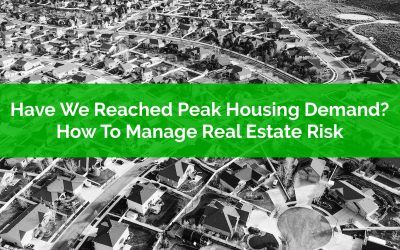Thank you for joining the waitlist!
You’re on the list for early access!
We will contact you via email when we’re ready for you to start your self-directed financial plan. In the mean time here is a quick preview…
Check out our latest blog posts…
Have We Reached Peak Housing Demand? How To Manage Real Estate Risk
Demographic trends can be extremely interesting. Demographic trends can influence a lot of things, they can impact voting and public policy, they can impact consumer trends, they can impact the consumption of goods and services.
The interesting thing about demographic trends is that they’re (somewhat) predictable. The way our population looks today will directly translate to how it looks in the future. Factors like immigration and advances in health care can change these trends slightly, but in general, the way people age is fairly predictable.
What is interesting about demographics is that as people age they do things differently, their behavior changes, their lifestyle changes, they consume different things.
Over the last 60+ years there have been two huge demographic waves, the first was the “baby boomers” and the second was their “echo”. These two groups are very noticeable when looking at population by age group. Demographic charts clearly show two huge population waves with troughs in-between.
Now, I’d like to preface this post with the fact that I hate predictions and forecasts. In my opinion, a good financial plan shouldn’t rely on predictions or forecasts to be successful. A good financial plan will prepare for various future events and still have a high chance of success. It’s important to anticipate possible risks and how they may impact a financial plan.
Typically, when we talk about risk we talk about investment risk and inflation rate risk. A good plan will still be successful even with changing investment returns and changing inflation rates. But what about real estate values? What about housing?
For two groups of people, the variability in real estate values should be a big concern when doing a financial plan. One group is real estate investors, people with rental properties that make up a large % of their assets. The second group is future downsizers, people who have made downsizing to a smaller home a key part of their future financial plan.
For these two groups of people it’s important to understand that real estate growth rates can vary and this creates risk. Simply assuming inflation, or inflation + xx%, is not a great strategy.
In this post we’ll look at how demographics may impact future housing demand and why a good financial plan should be prepared for different rates of real estate appreciation.
Why We Haven’t Purchased A Critical Illness Policy
Critical illness insurance is a unique type of insurance that will provide a lump-sum payment in the event of a critical illness. What is unique about critical illness insurance versus other types of insurance is that it is VERY specific about what is covered.
Unlike disability insurance, or life insurance, a critical illness policy has some very specific criteria that need to be met before benefits are paid out. While many people may feel that their illness is critical, a critical illness policy doesn’t actually cover many common illnesses but only specific “critical” illnesses.
The idea behind critical illness is good. It can provide financial support during a difficult period of time. A time that may see a decrease in income or an increase in expenses. It helps provide financial support during an unexpected and potentially life changing period.
But despite the benefits we’ve personally decided not to purchase a critical illness policy. We made this decision for a number of different reasons, which I’ll touch on at the end of the post, but first let’s review what a critical illness policy is and what it covers.
Warning: This is not insurance advice. These are my own opinions about critical illness insurance and shouldn’t be considered insurance advice. If you’re unsure if critical illness insurance may benefit you then you should speak with an independent insurance advisor.
What Are OAS Clawbacks? How Can You Avoid Them?
What are OAS clawbacks? How can you avoid them? How impactful are OAS clawbacks in retirement?
The typical retiree will receive an OAS benefit of $7,362 per year (in 2020) and over the course of a 30-year retirement would receive payments of $220,860 (in today’s dollars). That is a significant amount of retirement income!
OAS clawbacks can reduce this income all the way to zero. OAS clawbacks are 15% of net income, so they can have a big influence on a retirement plan. Experiencing full OAS clawbacks would mean that a retiree needs to make up this income on their own through extra investment assets. This may require hundreds of thousands in extra investment assets.
Avoiding OAS clawbacks is an important part of retirement planning. We’d like to avoid these clawbacks if possible. Through various strategies we can reduce or eliminate these clawbacks in retirement. This can be very beneficial to a retiree.
There are a few strategies that can help retirees avoid OAS clawbacks. Which strategy makes sense will depend on the retirees sources of income and their financial assets. In this post we’ve got 7 strategies to consider if you want to avoid OAS clawbacks in retirement.
But first, what is an OAS clawback?



